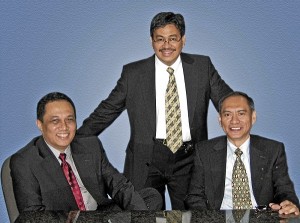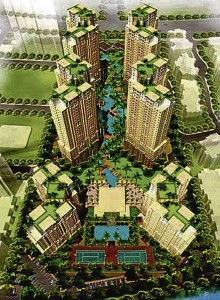Passion, discipline, desire for excellence tools for firm’s success

THE MEN behind PRSP Architects: (from left) Vicente ‘Jun’ Rodriguez Jr., Ronnie Simbulan and Pete Pimentel
Structures—from bridges to churches to towering buildings—can still leave most of us in awe. At times, these edifices can even define, to a certain extent, our heritage and culture, as they give us concrete reminders of how far we have come.
For the most part, architects play a crucial role in building these aesthetic visuals and skyscrapers that now adorn the country’s busiest thoroughfares and business districts.
Their eye for design, comfort and safety—an attribution that is sometimes overlooked—deserves to again be recognized. And this is why Inquirer Property is now shifting the limelight on architects, who can rightfully be called “builders and movers” in their own right.
Pimentel Rodriguez Simbulan & Partners (PRSP Architects), for one, has been providing Filipinos with world-class developments for more than a decade. Known for their comprehensive architectural services and engineering design, PRSP Architects has since been cited and conferred various recognitions.
In an interview with Inquirer Property, partners Pete Pimentel, Ronnie Simbulan and Jun Rodriguez gamely shared their journey—hardships, joy and fulfillment that go with the job.
Q: When and how was the company established?
JR: It was November 1988. I met my partners, Pete Pimentel and Ronnie Simbulan, at the ADB project in Ortigas back in 1987. [We were] employed under the firm of Skidmore Owings & Merill (SOM). When our contracts with SOM were about to expire, we then decided to merge our expertise.
[Our] first project was a mid-sized outlet of the Anson’s Appliance Store on Edsa corner Pioneer Street in Mandaluyong. Then, the first high-rise building would be the Renaissance Tower, a mixed-use building of office and residential condominium.
Q: Can you name some of your clients and the structures that you’ve built and designed?
JR: Our major clients would be Rockwell Land and Ayala Land with their sister companies, Avida Land and Amaia Land.
Our projects with Rockwell includes One Rockwell, Rockwell Business Center, The Grove, The Edades Tower and The Lopez Tower; with Ayala Land are One Roxas Triangle, Ayala Life FGU buildings on Ayala Avenue, Alabang and Cebu Business Park; with Avida Land are Avida New Manila, Avida San Lorenzo Makati, Avida 34th at BGC, Avida Donada on Taft Avenue and Avida QI. At QC; with Amaia Land are Amaia Skies Cubao on P. Tuazon, Amaia Skies Avenida in Manila and Amaia Skies Sta Mesa on V. Mapa.
Q: What were the initial challenges you encountered while putting up the company?
JR: At the time we merged, all of us were very young, myself at 27 years old. The biggest challenge would be how to establish your name right away as a firm—with all the reputable names [in the] building industry such as GFFormoso and WVCoscuella.
Q: How did you overcome these and what made you decide to pursue this business?
JR: We applied whatever experience and discipline we gained while being employed under SOM and adapted it with whatever project we had in the beginning. [There were] no shortcuts. [We aimed to be] distinct in the way our project presentations were done. Also, [we gave] personal attention to every need of the client.
We decided to pursue our business after we were given the break to work with Ayala Land way back in 1989, when they were in talks with Citibank for their office headquarters in Makati. The excitement and fulfillment we got from our earlier projects made us want to venture more.
Q: Has it always been your dream to build structures?
JR: When much younger, I was always exposed with the construction of buildings since my grandfather was the person in charge of building the De La Salle Buildings under the general contractor, A.M. Oreta.
PP: Yes. When I was still young, I enjoyed watching houses or buildings being constructed so I said to myself that when I grow up, I would do the same. But I initially wanted to be an engineer because my two uncles were both engineers. Then late in high school, the course Architecture fascinated me.
RS: No. Early on, I knew that I could draw, but I was leaning toward priesthood, having grown up with priests. I had this uncle who told me that with my talent in drawing, I could be an architect. Still, in high school, I was into arts and paintings, a frequent competitor in school contests. But I wanted a career that would be both artistic and stable so I pursued Architecture.
Q: Who has the greatest influence in your lives? Who would you consider as your mentor?
JR: My grandfather, but then it was my father who honed me to pursue Architecture.
I would consider my professor in UST, Arch. Jose Pardo, as my mentor as he was responsible for my first employment [and also] my first employers, architects Engracio Mariano and Cresenciano De Castro—all established names in the industry.
PP: It would be my father. He was the one who taught me to value everything that I learn.
For my mentor, I would consider the late Arch. Maximo Caldelaria who taught me the style of drafting, construction documentation and up to construction stage of the building.
RS : My uncle, he gave me the idea of a career in Architecture.
I consider a number of people as my mentors: Arch. Sindiong, who was my first employer; Arch. Matubang who was my supervisor in rendering/artistic techniques; as well as Arch. Payumo who taught me a lot also.
Q: What do you think is the secret behind your company’s success?
“We believe that discipline, consistency, unwavering desire for excellence and a healthy and happy working environment are ingredients to our success,” the group said.
Q: Is there any particular belief/mantra that you follow?
“Never waver in your passion for success—no compromises and mediocre work at any time. Always give special attention and make time to do hands-on involvement in our projects, and attend to clients’ needs personally,” the group claimed.
Q: What’s the greatest reward that you’ve received from being one of the biggest players in the architecture business?
“Aside from the awards for consistently being one of top firms in the Philippines for seven consecutive years now, no bigger award can be compared when people approach you and praise you for the excellent work that you have done for your projects, and of course, the reward of having your clients stay with you through all these years.
Q: What do you think is your company’s greatest contribution to society, to the real estate industry in particular?
“It would probably be working for the leaders in the industry today (like Rockwell Land and Ayala Land) since they are considered to have pioneered and developed the trend-setting projects in the industry today,” they noted.
“We are fortunate that we are part of the team that create and design spaces that give new/enhanced meaning to business environments and residential communities,” the group added.
Q: What legacy would you want your developments to leave behind?
“[We want] our projects to remain as landmark projects and be able to stand the test of time. We also want to be remembered as one of the movers in the latest trends in the industry and to be identified with the biggest players in the industry—that is, Rockwell Land and Ayala Land,” they said.
Q: What is that one project you dream of building that you think could entirely change and improve the way people see infrastructure?
“If this is something for the future … maybe, a mobile high-rise structure? Something that you can relocate to any site if needed to. We can dream, right?” the group concluded.
